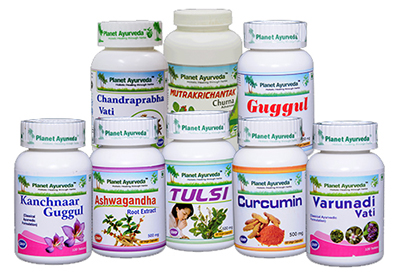Herbal Remedies For Testicular Cancer
Abstract
Testicular cancer is a condition in which the unusual cell grows out of control in the tissue of one or both of the testes. No other organ of the body is victim to such a wide variety of malignant neoplasms as the testis. Generally testicular cancer starts with benign neoplasm which then aggressively turns into malignant. This type of cancer is capable of rapid and wide dissemination. In this article we will discuss testicular cancer in detail, about it’s symptoms, types, stages, risk factors, diagnosis and treatment. We will also discuss the ayurvedic management of this condition.

Introduction
Most of the testicular cancers arise from germinal cell tumors and spread rapidly. But fortunately the seminoma type of testicular cancer is quite radiosensitive. Around 95% of the males generally survive for around five years after being diagnosed with testicular cancer. The survival rate depends upon how early the diagnosis is done. Later the diagnosis, less chances of survival. Testicles are the part of male reproductive system. Testes are the small organs that are present as a pair and are smaller than the size of golf ballin adult males. These are held in a sac of skin called scrotum and scrotum is present under the base of Penis. Testicles have two main functions:
- Testosterone (male hormone) is made by them.
- Production of sperm is also done by testis. Sperms are the male cells needed to fertilize female eggs.
Testicular Cancer Risk Factors
- Age: Half of the cases are in men in their 20s and early 30s.
- Race: White men are more prone to testicular cancer.
- Undescended Testes.
- Unusual Testicle Development.
- Family history of testicular cancers.
- HIV positive people are prone to develop odds of seminoma.
Testicular Cancer Types
Greater than 95%of testicular cancers start with germ cells. These cells are responsible for sperm production. These germ cell tumors are divided into seminomas and nonseminomas. The mixed cell tumors are treated as nonseminomas as they grow and multiply like nonseminomas.
Seminomas
Theseare further divided into classical and spermatocytic seminomas.
The classical seminoma affects around 90% of the population and on the other hand spermatocytic seminoma is rare and is noticed in old males after the age of 65 years on an average. Some semonimas are capable of increasing blood levels of a HCG protein (Human chorionic gonadotropin).
Nonseminomas
These are of four types, embryonal carcinoma, yolk sac carcinoma, choriocarcinoma and teratoma.
1. Embryonal Carcinoma
These Cells are generally involved in 40% of testicular tumors. The affected tissue when examined under a microscope appears like an early embryo. They increase the tumor marker protein called alpha fetoprotein as well as HCG.
2. Yolk Sac Carcinoma
These tumors look like a yolk sac of early human embryos. It has many synonyms like endodermal sinus tumor, infantile embryonal carcinoma and orchid blastoma. It is the most common form of testicular cancer in children but quite rare in adults. This type also increases the alpha fetoprotein levels in tumors.
3. Choriocarcinoma
It is very rare yet very progressive and fast growing testicular adults. It has a typical characteristic feature of metastasis (spreading to other parts of the body). Presence of choriocarcinoma is always worrisome.
It tends to increase the HCG levels in blood.
4. Teratoma
These are the tumors that if examined under a microscope will look like each of the three layers of embryo. Endoderm (innermost layer), mesoderm (middle layer) and ectoderm (outer layer). This type does not tend to increase the HCG or alpha fetoprotein levels (AFP).
Teratomas are of three types:
1. Mature Teratomas
They rarely spread and can be cured by surgery.
2. Immature Teratomas
These Are the less developed cancers with cells that appear like embryos in their early stages. They have a tendency to spread that is metastasized.
3. Teratomas with somatic type malignancy :
It is a very rare type. They can be understood as the result of already existing somatic cancers.
Stromal Tumors
These are often harmless but can be cancerous. They are generally present in 5% adults and 20% boys.
The two main types are:
1. Leydig Cell Tumor
Tumor formation generally start in cells in leydig cells in the testis that normally make male sex hormones. They have a tendency to develop in both adults and children. They generally present in the form of a single tumor but if they spread they do not respond well to chemotherapy.
2. Sertoli Cell Tumor
The normal sertoli cells generally support and nourish the sperm making germ cells and the same like leydig cells do not respond well to chemotherapy or radiation.
Stages Of Testicular Cancer
- Stage 0: The cancer is diagnosed in the seminiferous tubules only.
- Stage 1: Cancer limited to testicles and testicular tissues.
- Stage 2: Metastasis is present through abdominal lymph nodes and involvement of abdominal organs can be seen.
- Stage 3: Metastasis will be noticed to distant lymph nodes and involvement of the respiratory system, brain, liver can be noticed.
Symptom Of Testicular Cancer
- Changes in the testicles can be noticed . One may feel firmer and bigger than the other.
- A painless lump can be felt.
- Weight in scrotum with or without pain.
- Collection of fluid in testicles.
- Pain and dull ache in scrotum.
- Early signs of puberty in young boys.
- Lower back pain.
- Lower abdominal pain.
- Headaches or confusion.
- Low sexual urge in males (due to hampered production of testosterone).
Diagnosis
- Ultrasound to see the size of growth and determine whether it’s cancerous or benign.
- Blood test for high HCG or alpha fetoprotein.
- Biopsy of testicular tissue. Biopsy in this case plays a very important role. As through biopsy generally the type and character of growth is determined. Biopsy is done to determine whether the growth is carcinomatous or not.
Testicular Cancer Treatment
The method of treatment in modern science is determined keeping in mind the age of the patient. During early stages as mentioned before this cancer does not show any specific signs. So physicians guide their patients to keep an eye on the growth. But if the patient present with symptoms as well as the diagnosis made is of stage 2 or 3 then following treatment are to be considered:
Radiation Therapy : To kill cancer cells in lymph nodes and testicular cells.
Chemotherapy : To arrest the cancerous cells in the proliferation stage and hence preventing their differentiation. Thus also helps in destruction of cancerous cells but also causes destruction of healthy cells.
In early stages orchiectomy (testicular removal) can be of great choice.
In ayurveda this condition is understood as arbuda. The causes of arbuda are explained as vitiation of kapha dosha and fatty tissue. Malignant tumors do not suppurate or do not have discharge of pus, blood or fluid. In addition ayurveda explains certain characteristics of tumor like vritham (round), manda ruja (slightly painful), mahant (big size), unalpa moolam (deep seated), chirvirrudhi (slowly increasing), apakam (non-suppurating) and sthiram (immovable).
Planet Ayurveda
Planet Ayurveda is a GMP certified herbal manufacturing unit that deals with the manufacturing of herbal products. These products are prepared using potent herbs and their standardized extracts. Planet Ayurveda products do not cause any side effects and thus can be used freely. The products that are being offered for the management of testicular cancer are as follows:
- Crab Care Pack
- Mutrakrichantak Churna
- Varunadi Vati
PRODUCTS DESCRIPTION
1. Crab Care Pack
This pack is exclusively made for management of various types of cancers and includes Ashwagandha Capsules, Curcumin Capsules, Kanchnaar Guggul, Tulsi Capsules, Guggul Capsules and Chanderprabha Vati.
- Ashwagandha Capsules
Ashwagandha capsules are prepared using the standardized extract of Withania somnifera, a herb that helps in increasing the body’s Immunity and is often known as sharir pushtikarak. This herb is known from ages to increase the body’s metabolism and hence provide with improved and stable immunity which is very important in order to fight cancerous cells.
- Curcumin Capsules
Curcumin is the extract of Curcuma longa (haridra). It has anti inflammatory effects, antibacterial and analgesic properties. Use of this formulation reduces symptoms like pain in scrotum, lower back, pain abdomen and swelling over testes.
- Kanchnaar Guggul
This is a classical herbal formulation which can play a very important role in supporting cancer patients. The main ingredients of this formulation are kachnar Kanchnaar bark (Bauhinia variegata), amalaki (Emblica officinalis), bibhitaki (Terminalia bellerica), haritaki (Terminalia chebula) etc. Kachnar Kanchnaar bark extract has cytotoxic properties thus supports in arresting proliferation of cancerous cells.
- Tulsi Capsules
Tulsi (Ocimum sanctum) is known to have many properties but in testicular cancer patients it can be used as an antioxidant and also prevents metastasis. Cancer is a condition which generally occurs due to accumulation of free radicals in the body so it also helps in removal of free radicals from the body.
- Guggul Capsules
This is manufactured using Commiphora mukul. Guggul is potent in showing anti inflammatory properties and fighting various degenerative conditions. It also cleanses the circulatory system.
- Chanderprabha Vati
Chanderprabha vati is a classical herbal formulation that has guggul resin (Commiphora mukul), amalaki (Emblica officinalis), Haridra (Curcuma longa) and many more potent herbs as its ingredients. These all combinedly help in improving and maintaining the body’s immunity.
Dose: One capsule twice a day after meals.
Dose: One capsule twice a day after meals.
Dose: Two tablets twice a day after meals.
Dose: Two capsules Twice a day after meals.
Dose: Two capsules twice a day after meals.
Dose: Two tablets twice a day after meals.
2. Varunadi Vati
Varunadi vati is a classical formulation which is prepared using shuddha guggulu (Commiphora mukul), gokshura (Tribulus terrestris), varuna (Crataeva nurvala), and punarnava (Boerhavia Diffusa). It helps in removing excess water content from the body. In this case it avoids accumulation of fluid in the scrotum.
Dose: Two tablets twice a day after meals.
3. Mutrakrichantak Churna
Mutrakrichantak churna is a classical formulation that contains varuna (Crateva nurvala), gokshura (Tribulus terrestris), punarnava (Boerhavia diffusa), kaasni (Chicorium intybus) etc. This formulation also helps in avoiding accumulation of fluid around the testicals.
Dose: Half tsp twice a day after meals.
Conclusion
Cancer is the type of condition that has deep roots in the community. The fight back to cancer is really of an hour. Potent herbs can help to do so and hence provide the patient with enough strength and immunity not to lose hope in life.






